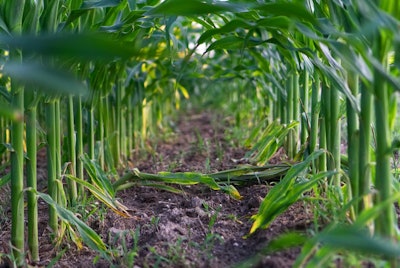
Recommended citation format: Schnitkey, G. "IFES 2018: Crop Returns: Trade Disputes Leading to Lower Returns?." Department of Agricultural and Consumer Economics, University of Illinois at Urbana-Champaign, December 28, 2018. Permalink
This is a presentation summary from the 2018 Illinois Farm Economics Summit (IFES) which occurred December 17-21, 2018. A complete collection of presentations including PowerPoint Slides (PPT) and printable summaries (PDF) are available here.
The trade dispute between the U.S. and China is a major factor impacting 2018 and 2019 incomes. Because of large exports to China, U.S. soybean prices have declined because of tariffs placed on U.S. exports to China. From 2015 through the first part of 2018, soybean prices averaged in the high $9 range. Since the trade dispute, soybean prices have been below $9 per bushel, with some cash prices being below $8 per bushel.
While the trade dispute has had negative impacts on soybean prices, 2018 net incomes on many grain farms could be above 2017 levels. Factors contributing to higher 2018 incomes include:
- Exceptional yields. Most Illinois farmers had exceptional yields. These exceptional yields will raise incomes.
- Opportunities to price grain at higher prices during the spring. Both soybean and corn prices fell dramatically in late May after tariffs began being placed by the U.S. and Chinese governments. Many farmers prices a portion of expected production in spring.
- Market Facilitation Program (MFP) payments. MFP payments will add significantly to income.
For 2019, incomes could average negative for many farms if corn prices continue to be near $3.50 and soybean price average around $8.50. In this price scenario, average net income on Illinois grain farms could average near -$60,000 if yields return to trend levels. Exceptional yields like those in the last several years could cause incomes to be near $0, or roughly 2015 levels.
Incomes like those in recent years are possible. A combination of higher prices and another round of MFP payments would increase 2019 incomes. Other scenarios could occur resulting in higher incomes.
Still, it seems prudent to plan for low 2019 incomes. If possible, saving cash flow from 2018 income will serve as a buffer for low incomes in 2019. Also, preparing two different 2019 cash flows using two yield projections.
- Five-year average yields: these yields will most likely be relatively high given recent record-breaking yield years.
- Approved yields for crop insurance: these yields will be lower than the five-year average yields in most cases.
If the cash flows, given these lower yields are negative, contingency plans should be made to cover these losses.
Finally, it seems prudent to discuss the economic situation with landowners. If soybeans less than $9 per bushel continue into the future, significant downward adjustment in cash rent will need to occur.
Additional Resources
The slides for this presentation can be found at:
https://www.farmdoc.illinois.edu/presentations/IFES_2018
For current farm management information
https://www.farmdoc.illinois.edu/manage/index.asp
Schnitkey, G. and K. Swanson. “2019 Crop Budgets Suggest Dismal Corn and Soybean Returns.” farmdoc daily (8):173, Department of Agricultural and Consumer Economics, University of Illinois at Urbana-Champaign, September 18, 2018.
Schnitkey, G. and K. Swanson. “What Could Change the 2019 Corn and Soybean Return Outlook?” farmdoc daily (8):200, Department of Agricultural and Consumer Economics, University of Illinois at Urbana-Champaign, October 30, 2018.
Schnitkey, G. and K. Swanson. “Financial and Risk Management Decisions for 2019.” farmdoc daily (8):209, Department of Agricultural and Consumer Economics, University of Illinois at Urbana-Champaign, November 13, 2018.


















